Shannon Hums While Cleaning My Teeth & The Garden Will Be Done
Saturday, April 12, 2008
 I have always disliked going to the dentist and to the barbershop, because invariably you become a captive audience to one who talks unceasingly. Half of that problem has been solved and I won't tell you which. Since the advent of no cavities (I guess I now brush my teeth regularly) quite a few years ago the issue of the talking dentist has been replaced by the problem of my dental hygenist, Shannon, who hums to all the soft rock that is piped into the room. Yesterday,
All my troubles seemed so far away,... But Shannon compensates with an excellent system of cleaning (scraping) my teeth. This is something I don't like but she makes it seem quicker because she uses a random approach. I don't have to think, "She's done the upper outside so now I have to suffer the... She scrapes here and there, has me all confused and before I know it she is through and the humming stops. I was thinking about Shannon today as I worked in the garden. I moved a Mahonia from this bed to that bed. I put sand (to smother it) on moss in that bed. I fertilized the roses with liquid fertilizer. I pushed back the Choisya 'Aztec Pearl' so it will give room to Rhododendron schlippenbachii to grow. During all this work I realized I was not going at it methodically but using Shannon's method. Before I know it the garden will be "done". For lunch today I made strawberry slush with strawberries, lemon juice, sugar and plenty of ice. Rebecca said, "Um, so good. I can't wait until summer so we can drink this in the garden.
Diane Farris, The Montgomery Café & Hovering Buzzards
Friday, April 11, 2008

In 1999, when photographer Fred Schiffer (one of the best portrait photographers Vancouver has ever had) died I attended his memorial service. I was near Olive Schiffer when the hovering "buzzard" pounced, "How would yo like to keep the memory of your husband's excellence alive? If you donate all his photographs to our archives that will happen." It was at that moment that I was hit by an internal fury and a determination that no buzzard shall alight on Rosemary should I make my earthly exit before she does.
A couple of weeks ago I received a call from gallery owner Diane Farris. She wanted to know who could help her obtain information about the Montgomery Café that used to be on Pender very close to the Niagara Hotel. While she was chatting with me I went down to my basement files (10 large metal filing cabinets with four drawers each) and under M I extracted my Montgomery Café file. Under F I removed the Diane Farris folder. I told Farris that John Mackie at the Vancouver Sun was her best bet and she rung off. But not before we mutually commented on the fact that I am exactly one day older than she is as I was born on August 31 while her birthday is on September 1.

My photograph of the Montgomery Café is nothing to rave about but it does show that the place was known for the art on the walls, the painted tables, the cow hide nooks and the excellent shakes. My picture of Farris I took in her original gallery on Water Street and the man behind her is her former husband.
It occurs to me that when I take my leave (as of now my files have 37 year's worth of stuff related to Vancouver) my files will be deemed valuable by many. It will be too late for me to be rich and famous. But I do have a little ace up my sleeve. I have made a will in which I stipulate to my wife and daughters that my photographic life's work:
1. Shall be sold.
2. Not donated to any archive.
And if 1 is not met the instructions are:
3. Burn.
From somewhere I know Fred is smiling and he approves. As for keeping my memory alive I will take the cue from my friend Abraham Rogatnick, "After me, nothing."
Con Alma
Thursday, April 10, 2008
 My On Line RAE (Real Academia Española) dictionary of the Spanish language defines alma as: alma
(Del lat. anĭma).
1. f. Principio que da forma y organiza el dinamismo vegetativo, sensitivo e intelectual de la vida. Unlike soul (the equivalent in English) alma comes from the Latin anima so it has a slightly different flavour in both sound and meaning. Translating the above definition alma is defined as the principle that gives form and organizes the vegetative, sensitive and intelectual dynamism of life. It is perhaps because of that askew meaning to alma with no side definitions associated with soul music (as an example) that I find Dizzy Gillespie's composition Con Alma so special. It is beautiful and the name, in Spanish, is icing on that cake. When I take Rebecca to her ballet classes on Wednesdays I always insert a new CD with a track of my choice. She always wants to know what we are listening to. Her last "in-car-hit-parade" was Bach's Toccata in D minor for organ, ("That Dracula, piece,"in Rebecca's words). Her choice now is track 2 of Dizzy Gillespie Con Alma . This is a 9 minute 25 second version of Gillespie's classic. The CD has no liner notes. No explanations are given and by the sound of the album I had nailed my Argentine countryman Lalo Schifrin on the piano. Rebecca thinks the song is lovely. I have a fondness for the constant maraca beat. At first Rebecca was confused when I told her Gillespie was playing the trumpet. She expected the open horn sound. In this tune Gillespie starts with a muted horn and only plays the open horn later on. The sax player (on tenor sax) is particulary good and I had guessed he was James Moody.  I was wrong on all counts. I woke up my friend alto saxophonist Gavin Walker today and we did some research on what he calls minutiae. The clincher was the 9 minute 25 second duration of Con Alma. He identified the sax player as Sonny Stitt and the piano player as Ray Bryant. Drummer Charlie Persip is perhaps the one with the maracas. Before Gavin rang off he said, "Make sure you tell Rebecca that she has good taste." I would not want to confirm Walker's statement as that would mean that I have good taste, too! But Rebecca and I seem to agree. We both love listening to the many versions of Gerrry Mulligan playing My Funny Valentine. I will have to introduce her soon to that classic Brubeck composition The Duke (in honour of Duke Ellington)or my different versions of I Didn't Know What Time It Was particularly the one with Lester Young. And then there is Charlie Haden's (Quartet West- In Angel City) First Song (For Ruth). But then there is the Stan Getz (with Kenny Barron on piano) interpretation of First Song (For Ruth)... Will I be able to get all this into Rebecca before we are cut off at the path by her emerging teenagehood?
Swirling That Material - Martha Graham, Judith Garay, Simone Orlando
Wednesday, April 09, 2008
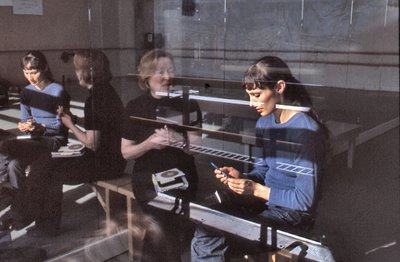 I have been on this tack before but I am so moved when I happen to notice it that I cannot resist. On page 1 of Roland Barth's Camera Lucida he observes: One day, quite some time ago, I happened on a photograph of Napoleon's younger brother, Jerome taken in 1852. And I realized then, with an amazement I have not been able to lessen since: "I am looking at eyes that looked at the Emperor." Sometimes I would mention this amazement, but since no one seemed to share it, nor even understand it (life consists of these little touches of solitude), I forgot about it. My interest in Photography took a more cultural turn.On the other Monday Lauren and I attended a rehearsal of Dancer's Dancing. In spite of the opportunity to watch a work in progress and get a glimpse into the mind of a choreographer there were no more than 10 in the audience including Ballet BC dancer (not dancing these days because of a bad hip injury) and choreographer Simone Orlando. It was all very pleasant but I was saving my excitement for Desirée Dunbar's solo performance. I was not disappointed. Dunbar was wearing a long purple dress/skirt/cover that she swirled so that you could see her beautiful and muscular legs. And she swung around a large collection of purses (I will not explain except to say that when Lauren looked at all the purses on the floor, before the performance, and questioned me, I just said, "Perhaps she is going shopping.") I chatted with Dunbar after and found out she is from Lillooet. I told her about my daughter who teaches there. But I found the time to ask her, "The swirling skirt - does that have anything to do with Judith's (Judith Garay) former mentor (Martha Graham)?" Dunbar answered, "Yes." It is no accident that the most famous photograph of Martha Graham (and one of the most famous photographs of dance) taken by Barbara Morgan features Martha Graham in a swirling dress. 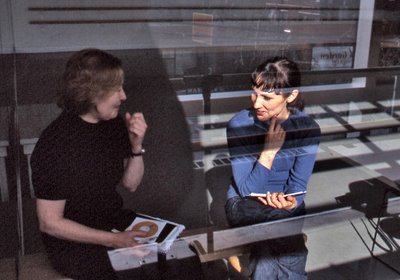 As I left and spied Judith Garay and Simone Orlando chatting I wondered if soon, Orlando might not choreograph something that has swirling dresses. I would bet on it.
D' Artagnan's Girl Revisited
Tuesday, April 08, 2008
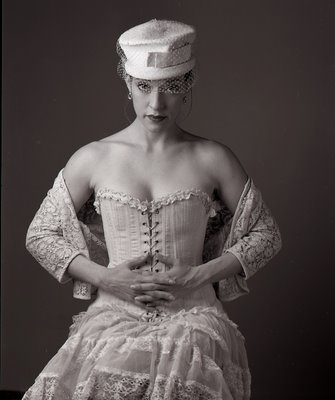 I find it amazing that the apparent demise of photography is greatly exagerated. I have eager students at Focal Point who pay good money to listen to me talk about the problem with contrast in photography (most ignore it to their peril) or my constant criticism on the appearance of those terrible neck folds in their portraits or nude studies. Here are some pictures of Marthe in 1998. They are full of neck folds and, even worse, bad crops of legs and other extremeties. It would seem that what I now teach I have only learned most recently. But at the same time there is a quality that I can discern in these pictures that has all to do with my experimentation of different posing and shooting techniques on a seasoned dancer with flexibility, strength and a womanly presence in spades. Yesterday I visited Horst Wenzel who tightened some screws on the cocking lever of my Mamiya RB-67. He asked me if I was still taking nudes. He also asked me why I do this. I explained as I explain to all my classes that the photography of nudes is a great help in the posing of the clothed. In my nude sessions in the studio there is no particular goal in my mind. I am not to take a head shot, or a profile that is to bleed on a page. Or it is not a picture that will appear on a magazine cover and I have to watch for room on the bottom left to allow for a bar code. With inside magazine covers I have to be conscious that if it is a two-page spread the magazine gutter might split my subject's face. Of late I have chosen in my fun/experimental shoots to use faster film with no flash. I have been finally taking advantage of my big studio windows. I have written about other reasons for the photography of the female body here. 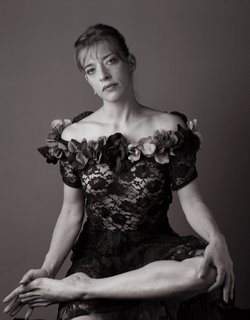 With Marthe I had the obsession (one that is yet to diminish) of capturing that aspect of classical dancers and modern dancers that has nothing to do with grace, ease of movement or the ethereal presence of a swan. I wanted to and still want to reveal their woman aspect.  Today in the afternoon I will have the tall and strikingly beautiful modern dancer Delia Brett in my studio. She is going to appear with her 7-year-old son Beckett. Beckett looks exactly like his mother. I have never ever spoken to Miss Brett but I have seen her in performance. I only wonder why nobody has yet to assign me to photograph her. So I approached her. For those who are not familiar with the portrait photography of the German August Sander, it was this man whom I most admire for his quality of capturing a person's essence in particular to the person's profession. Sander captured for all time the essence of the young German soldier. This was an essence that lied nonetheless. But his portraits of bakers, policemen, Jews (those taken in 1938 are poignant as you know that perhaps a year later they would be dead) and the town beggar ooze with honesty and a respect for who they are.  Today I want to extract an August Sander type of picture that could be labeled "Dancer & Son". I have no other plans, no predisposed ideas and lots of excitement.
D'Artagnan's Girl
Monday, April 07, 2008
Last night I finished the latest novel by Cartagena born author Arturo Pérez-Reverte. It is from a series featuring his swashbuckler 17th century soldier of fortune Capitán Don Diego Alatriste. It is the 6th in the series. The first two were somehow translated into English even though these novels are written in a pseudo 17th century Spanish which is quite complex and the stories require a fair knowledge of Spanish history. I never knew, for example that Flanders was to Spain what Vietnam was to the US. In fact most of the gold and silver brought in Spanish galleons from her New World possesions disappeared there.
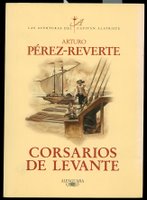
Pérez-Reverte has the Dumas nerve to announce the name of the three forthcoming sequels. I cannot wait. Feeling a tad depressed when I placed my book on the bedroom floor I went downstairs to look for the author's first compilation of his weekly columns for the Spanish literary magazine El Semanal. I doubt that Patente de Corso 1993-1998 (that translates to letter of marque) or its sequel Con Ánimo de Ofender (with a desire to offend) 1998-2001 will be translated into English soon.
I immediately found my most favourite essay, La Novia de D'Artagnan, which is an account of his experience with a young woman at a Buenos Aires bookstore signing. I took the liberty of translating it and hope that Alfaguara (Pérez-Reverte's publisher) does not sue me. When I finished Corsarios De Levante I felt sad that I know nobody with whom I can share my pleasure. I remembered the young girl's plight. Here it is, badly translated by me. But in spite of it I hope you understand my predicament and sadness.
D'Artagnan’s Girl
Arturo Pérez-Reverte
I figured she was in her early 20s. She was in the third or fourth row in that Buenos Aires bookstore where this author was signing. She seemed quiet and shy. She had a backpack full of books and when she finally faced me she took out a tattered copy of The Dumas Club which she had obviously read many times.
“I love D’Artagnan,”” she affirmed, “and the others.” Her voice quivered as if she had just confessed a prohibited or strange passion. She seemed like she was about to say more but didn’t and just stared at the book I now had in my hands. I wrote some warm words on the first page, I chatted with her and from there I shifted my attention to a 60-year-old woman, very handsome, with green eyes which must have been devastating on others in her time. While we chatted about Seville and the bars of Triana, I noticed that the young girl who loved D’Artagnan remained amongst the shelves with her backpack on her shoulder. An hour later, after saying goodbye to the owner and my friends she was still at the door. “I need to show you something,” she said. Her voice trembled, as if the effort to speak to me was difficult. “Please,” she added. We were next to Patio Bullrich, a fashionable mall near the Recoleta, so I felt I would not compromise myself to anything if we sat for five minutes over coffee. I looked at my watch, uncomfortably. I was in doubt.
“It’s too heavy,” the girl said as she pointed at her backpack. I began to laugh, and after a bit she did, too in her timid way. It would be impossible to not have coffee with someone who appeals to you with Porthos’s last words in the Grotto of Locamaria from The Man of the Iron Mask. So the young girl who said she loved D’Artagnan took the seat in front of me but sat on the edge. From her backpack she extracted some extremely used Alexander Dumas novels in old series installments. She had acquired them in old bookstors, she explained. Everything was there, The Three Musketeers, Twenty Years After, and The Vicomte de Bragelonne… She spoke. In spite of shyness, without even lifting her eyes from her books she spoke at length, without stopping, her many hours alone “traveling” the route to Calais, the corridors of the Louvre, fighting Jussac and the cardinal’s guards, flying the napkin at the bastion of St Gervais as a flag and escaping by sheer luck Milady's poisoned Anjou wine.
She knew it all better than I. And since she was a child, she affirmed. To prove it we played a game, a most entertaining game: The size of Constanza Bonacieux’s feet. Porthos’s three surnames. Beufort’s dog’s name. What woman uses the alias Maria Michon. Who is Bascarrat, in which chapter does he break his sword and in what chapter of Bragellone does his son appear. It what street does D’Artagnan live when he is a lieutenant of the musketeers. The only question she was not able to answer, evil Mordaunt’s father’s name, Milady’s secret son.
From the Musketeers we shifted to The Count of Montecristo and Queen Margot. From Dumas we went on to Sabatini, Salgari and the others, between Scaramouche, The Black Corsair and The Prisoner of Zenda. When I mentioned Rupert of Hentzau and Mexican swashbuckler actor Yáñez’s laugh I noticed she was crying. She did it silently and gracefully. Tears were running down her face and falling on the discoloured covers of her old books. I was disturbed so I asked her why she was playing this unpleasant trick on me. She lifted her face. She was serious: “I had never been able to talk about all this with anyone,” she said. I knew this was the truth. After I had paid for the coffees she began to slip her books into her backpack with a sweetness and care. She was careful not to bend the covers as if they were precious objects. She stood up and said, “I wish Ruritania existed.”
“It does,” I answered, “it borders Syldavia to the north and on the south with Castle If.”
She still had tears but I saw her smile. “Then, I will pay for the next coffee,” she said, “If we ever see each other in Zenda.”
After a fleeting kiss I saw her disappear in the crowd with her heavy backpack full of dreams.
Arturo Pérez-Reverte

When I thought on how I was going to illustrate this blog I remembered my fading and stained proof in dancer Marthe's files. She was from Montreal. I photographed her because she had the most amazing presence, strength and legs. Even though she is a bit older than the girl cited in Pérez-Reverte's account I think she is just fine.
swashbuckler
more swashbuckler
and more
A Fit Tiko Kerr - A Young Boxer - An Older Little Girl
Sunday, April 06, 2008
 They say children grow up a lot sooner these days. Maybe that's not true and what is true from my point of view is that it took me a long time to do so.
In 1985 Vancouver Magazine dispatched me to photograph an article on boxing written by Jim Christy. It involved boxers like Tony Pep and Michael Olajide. In the end Olajide made the cover. Part of my assignment had me photograph several boxing matches. One thing is to see a boxing film and quite another is to hear the punches and see the blood. With me in all those matches was Vancouver Sun photographer Steve Bosch. He was the paper's boxing expert simply because he chosen years before the night shift. Most boxing matches happen at night. The young, athletic and beautiful Olajide was matched against an older white man who was going to be his cannon fodder and he would allow Olajide to climb up into stardom. The fight was no match and the older man was being devastated by continuous and well placed punches. The man's trainer threw in the towel on to the ring. The old man lowered his guard. Olajide noticed that the judges had not seen this so he swung at the man with a punch that floored him for the ten-count. I was too amazed to take any picture. Next to me Bosch's motor drive whirred away. He got his shot. I didn't. It was then that I gained a great respect for the true newspaper photographer who somehow manages to suppress instincts and emotion to get the job done.

Three weeks ago Lauren, Rebecca, Rosemary and I went to VanDusen and we watched an "opera" that included two male Canada geese and a female. It was a courtship that was being interrupted by a less agressive male who seemed to be desperate. Rebecca informed us that it was unlikely that latecomer would find a partner. She said this with confidence and with a matter of fact coldness. The fight between the two males got vicious. The dominant one was pecking the other with the determination of killing him. We were able to approach the pair to within a foot but we were ignored.

I could have gotten an exciting shot with my Nikon FM-2 in the way that I did not in earlier years capture Olajide's haymaker. But again I could not suppress my emotion. We shouted and threw dirt at the pair until the injured one was able to limp away. Rebecca was silent for the rest of the day. There was a look of sadness, almost agony in her face.
Yesterday we went to see Tiko Kerr's show at the Winsor Gallery. Rebecca was surly and did not want to go. I told her to turn off the computer. She was playing a game. "Make me," she said. I threatened to ground her (I have been given this authority by her parents and it involves a curtailing of computer and TV privileges for whatever length of time I stipulate). But I have rarely followed through with the threat and by the time we arrived at the gallery Rebecca was charmed by Kerr's paintings. Some were extremely large. I spotted the luminously beautiful Barbara Bernath (standing behind a computer in the gallery's back office) who in her youth played drums for such bands as 50% Off which was fronted by no less than Lincoln Clarkes. Rebecca enquired about the self portraits which were collages using hundreds of injection ampules and other medical paraphernalia. Trying to soften the blow I interjected that Kerr had haunted the back alley bins of the Vancouver General Hospital to find the stuff. Barnath interrupted to explain, very clearly, that Kerr who has AIDS, takes a huge amount of medication every day. "The AIDS virus will never go away," she explained to Rebecca. When we left Rebecca asked me (whispering so Lauren would not hear) on Granville, "Is Tiko Kerr g - a - y?" spelling out the word. I answered that he was and that he suffered for many years and had been near death until a special medication was provided only after newspaper articles and a general uproar in Kerr's favour had forced the medical bureaucracy to provide the drug. In the end Rebecca posed by her favourite Tiko Kerr painting which happens to be my favourite, too. It's the one with the float plane and the blue sky. Both of us were hoping it is a Beaver.

I explained that it was nice that a fit and happy Kerr now had sold many paintings for very good money. Bu Kerr's happy ending has come with a realization for Rebecca that life isn't easy and that it is not all fun and games. I think that knowledge is captured in a picture I have been afraid to post here. I took the picture in Lillooet in the fall. Rebecca borrowed Ale's (my daughter and her aunt) top. She wanted to look older. She does. I am sad. 
|

























